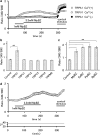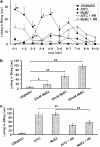Methyl p-hydroxybenzoate causes pain sensation through activation of TRPA1 channels
- PMID: 17351650
- PMCID: PMC2012982
- DOI: 10.1038/sj.bjp.0707219
Methyl p-hydroxybenzoate causes pain sensation through activation of TRPA1 channels
Abstract
Background and purpose: Parabens are commonly added in pharmaceutical, cosmetic and food products because of their wide antibacterial properties, low toxicity, inertness and chemical stability, although the molecular mechanism of their antibacterial effect is not fully understood. Some agonists of the transient receptor potential (TRP) A1 channels are known to have strong antibacterial activities. Therefore, a series of experiments was conducted to find out the effects of parabens on TRP channels expressed in sensory neurons, particularly the TRPA1 channels.
Experimental approach: Effects of parabens, especially of methyl p-hydroxybenzoate (methyl paraben) on TRP channel activities were examined using Ca(2+)-imaging and patch-clamp methods. In addition, an involvement of methyl paraben in the development of pain-related behavior in mice was investigated.
Key results: Methyl paraben specifically activated TRPA1 in both HEK293 cells expressing TRPA1 and in mouse sensory neurons with an EC(50) value of 4.4 mM, an attainable concentration in methyl paraben-containing products. Methyl paraben caused pain-related behavior in mice similar to that caused by allyl isothiocyanate, which was blocked by the TRP channel blocker, ruthenium red.
Conclusions and implications: Our data indicate that methyl paraben is able to activate TRPA1 channels and can cause pain sensation. As such, methyl paraben provides a useful tool for investigating TRPA1 function and development of antinociceptive agents acting on TRPA1 channels.
Figures






Similar articles
-
[Activation and regulation of nociceptive transient receptor potential (TRP) channels, TRPV1 and TRPA1].Yakugaku Zasshi. 2010 Mar;130(3):289-94. doi: 10.1248/yakushi.130.289. Yakugaku Zasshi. 2010. PMID: 20190512 Review. Japanese.
-
TRPA1 is differentially modulated by the amphipathic molecules trinitrophenol and chlorpromazine.J Biol Chem. 2007 Mar 9;282(10):7145-53. doi: 10.1074/jbc.M609600200. Epub 2007 Jan 11. J Biol Chem. 2007. PMID: 17218316
-
Activation of the chemosensing transient receptor potential channel A1 (TRPA1) by alkylating agents.Arch Toxicol. 2015 Sep;89(9):1631-43. doi: 10.1007/s00204-014-1414-4. Epub 2014 Nov 14. Arch Toxicol. 2015. PMID: 25395009
-
Ozone activates airway nerves via the selective stimulation of TRPA1 ion channels.J Physiol. 2010 Feb 1;588(Pt 3):423-33. doi: 10.1113/jphysiol.2009.183301. Epub 2009 Dec 14. J Physiol. 2010. PMID: 20008466 Free PMC article.
-
A new tr(i)p to sense pain: TRPA1 channel as a target for novel analgesics.Expert Rev Neurother. 2008 Nov;8(11):1675-81. doi: 10.1586/14737175.8.11.1675. Expert Rev Neurother. 2008. PMID: 18986238 Review.
Cited by
-
TRPA1-dependent and -independent activation by commonly used preservatives.Front Pharmacol. 2023 Oct 4;14:1248558. doi: 10.3389/fphar.2023.1248558. eCollection 2023. Front Pharmacol. 2023. PMID: 37860113 Free PMC article.
-
Intracellular alkalization causes pain sensation through activation of TRPA1 in mice.J Clin Invest. 2008 Dec;118(12):4049-57. doi: 10.1172/JCI35957. Epub 2008 Nov 13. J Clin Invest. 2008. PMID: 19033673 Free PMC article.
-
Lipid Raft Destabilization Impairs Mouse TRPA1 Responses to Cold and Bacterial Lipopolysaccharides.Int J Mol Sci. 2020 May 28;21(11):3826. doi: 10.3390/ijms21113826. Int J Mol Sci. 2020. PMID: 32481567 Free PMC article.
-
Inhibition of TRPA1 channel activity in sensory neurons by the glial cell line-derived neurotrophic factor family member, artemin.Mol Pain. 2011 May 27;7:41. doi: 10.1186/1744-8069-7-41. Mol Pain. 2011. PMID: 21619614 Free PMC article.
-
Lidocaine spray 10 min prior to intubation: effects on postoperative sore throat.J Anesth. 2010 Dec;24(6):962-5. doi: 10.1007/s00540-010-1013-3. Epub 2010 Sep 2. J Anesth. 2010. PMID: 20811918 Clinical Trial.
References
-
- Ankri S, Mirelman D. Antimicrobial properties of allicin from garlic. Microbes Infect. 1999;1:125–129. - PubMed
-
- Bandell M, Story GM, Hwang SW, Viswanath V, Eid SR, Petrus MJ, et al. Noxious cold ion channel TRPA1 is activated by pungent compounds and bradykinin. Neuron. 2004;41:849–857. - PubMed
-
- Bautista DM, Jordt SE, Nikai T, Tsuruda PR, Read AJ, Poblete J, et al. TRPA1 mediates the inflammatory actions of environmental irritants and proalgesic agents. Cell. 2006;124:1269–1282. - PubMed
-
- Bredin J, Davin-Regli A, Pages JM. Propyl paraben induces potassium efflux in Escherichia coli. J Antimicrob Chemother. 2005;55:1013–1015. - PubMed
Publication types
MeSH terms
Substances
LinkOut - more resources
Full Text Sources
Other Literature Sources
Medical
Molecular Biology Databases
Research Materials
Miscellaneous

